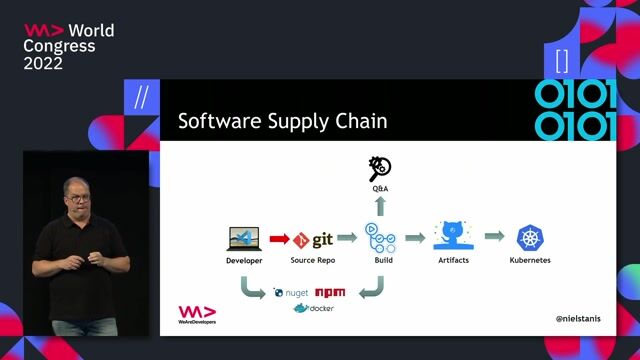Marcel Lupo
Best Practices for Using GitHub Secrets
#1about 2 minutes
Understanding the fundamentals of GitHub Secrets
GitHub Secrets provide an encrypted way to store sensitive data like API keys within repositories for use in CI/CD workflows.
#2about 6 minutes
Managing secrets at different scopes in the UI
Secrets can be managed at the repository, environment, or organization level through the UI, but repository-level secrets become difficult to rotate at scale.
#3about 5 minutes
Consuming secrets in workflows and avoiding common pitfalls
Reference secrets in GitHub Actions using the `secrets` context, but be aware of pitfalls like hard-coding, commit history exposure, and improper access control.
#4about 5 minutes
Integrating GitHub with Azure Key Vault for centralization
Use Azure Key Vault as a centralized secret store to manage secrets outside of GitHub, improving scalability and separating access controls.
#5about 7 minutes
Configuring passwordless authentication using OpenID Connect
Set up a federated identity in Azure Entra ID with OpenID Connect to allow GitHub Actions to authenticate to Azure without long-lived secrets.
#6about 7 minutes
Fetching Azure Key Vault secrets in a GitHub workflow
Use the `azure/login` action with OIDC to authenticate, then use Azure CLI within a workflow to retrieve secrets from Key Vault for subsequent steps.
#7about 4 minutes
Key benefits of the Azure Key Vault integration
Integrating with Azure Key Vault provides centralized management, granular RBAC, secret versioning and history, and enhanced auditing capabilities.
Related jobs
Jobs that call for the skills explored in this talk.
Matching moments

30:56 MIN
Securing workflows with secrets and best practices
CI/CD with Github Actions

41:45 MIN
Key takeaways for securing your application pipeline
Securing Your Web Application Pipeline From Intruders

40:22 MIN
Q&A on GitOps secret management practices
Securing secrets in the GitOps Era

23:48 MIN
Summary of how GitHub secures open source
How GitHub secures open source

05:30 MIN
Securing developer access and development tools
Securing your application software supply-chain

08:33 MIN
Preventing leaked secrets and managing dependencies
How GitHub secures open source

42:23 MIN
Q&A: GitOps, CI tools, and security management
GitOps: The past, present and future

07:34 MIN
The security risk of storing secrets in Git
Securing secrets in the GitOps Era
Featured Partners
Related Videos
 58:57
58:57Securing Secrets in the GitOps era
Alex Soto
 58:52
58:52Securing secrets in the GitOps Era
Davide Imola
 56:06
56:06Stop Committing Your Secrets - GIt Hooks To The Rescue!
Dwayne McDaniel
 1:04:54
1:04:54Lights, Camera, GitHub Actions!
Ixchel Ruiz
 29:50
29:50Real-World Security for Busy Developers
Kevin Lewis
 25:28
25:28How GitHub secures open source
Joseph Katsioloudes
 1:05:06
1:05:06CI/CD with Github Actions
Chris Ayers
 44:40
44:40Enabling automated 1-click customer deployments with built-in quality and security
Christoph Ruggenthaler
From learning to earning
Jobs that call for the skills explored in this talk.

DevOps Engineer – Kubernetes & Cloud (m/w/d)
epostbox epb GmbH
Berlin, Germany
Intermediate
Senior
DevOps
Kubernetes
Cloud (AWS/Google/Azure)


Senior Systems/DevOps Developer (f/m/d)
Bonial International GmbH
Berlin, Germany
Senior
Python
Terraform
Kubernetes
Elasticsearch
Amazon Web Services (AWS)




C# Developer - Fokus Azure DevOps Gestalten Sie unsere digitale Zukunft!
Kern & Partner Personalmanagement GmbH - Personalberatung
Remote
€47-60K
JSON
Azure
NoSQL
+2

